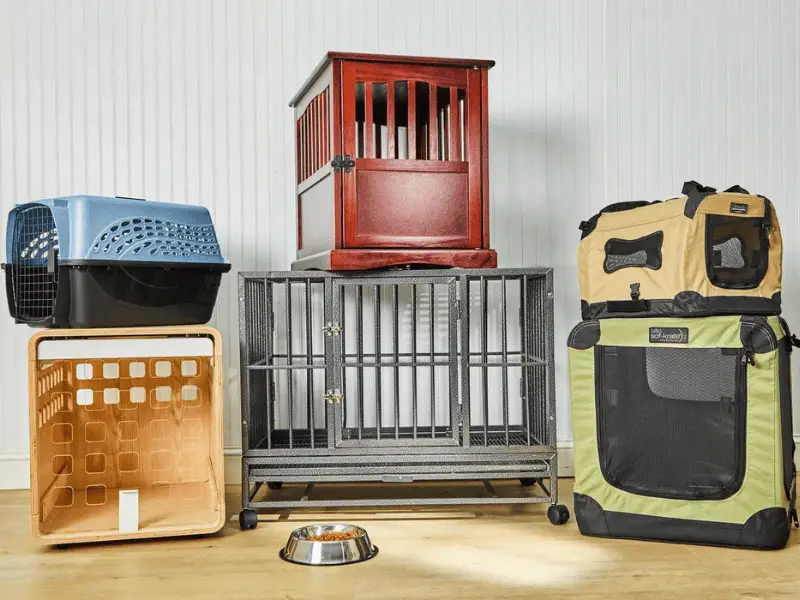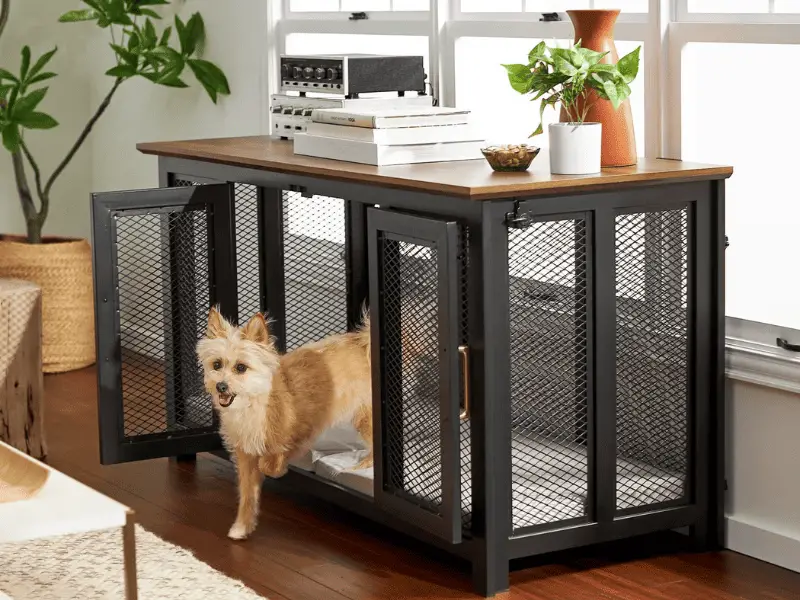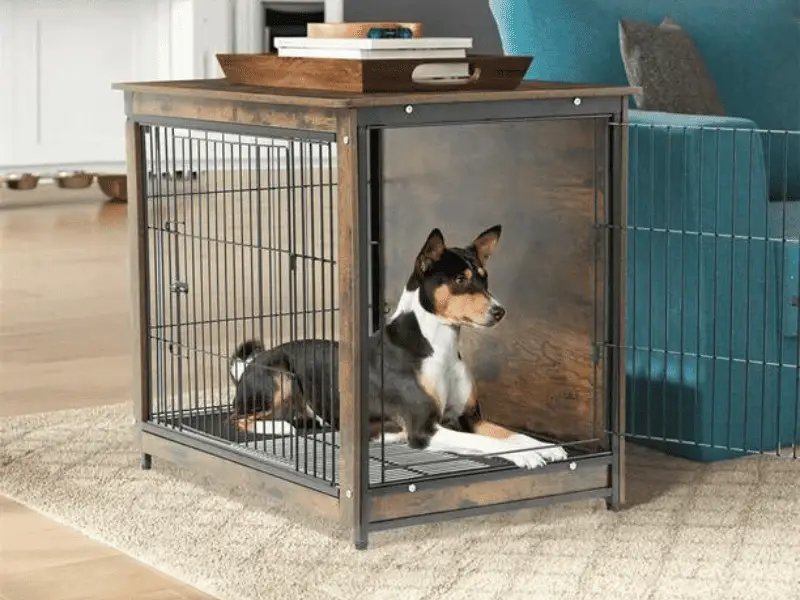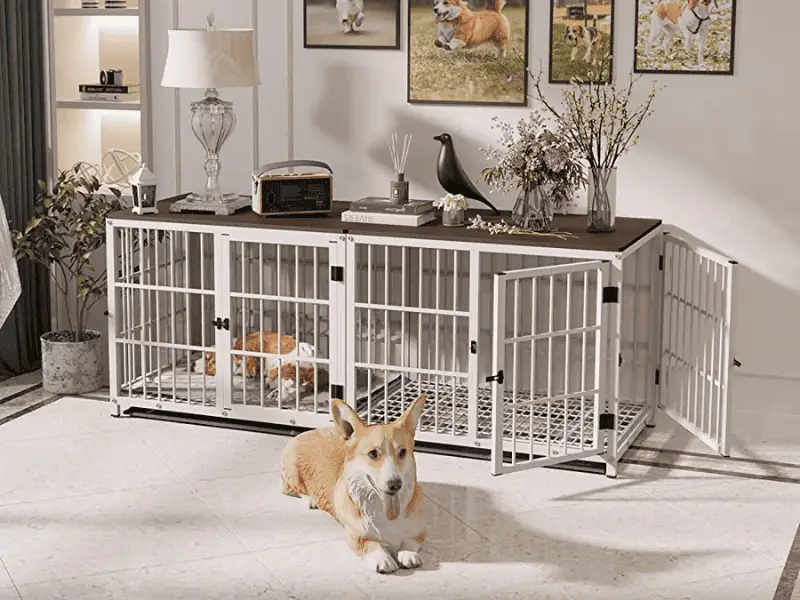Choosing the right size dog crate is crucial for your furry friend’s comfort and safety. In this section, we’ll explore the importance of selecting the appropriate space for your pooch. By understanding the factors to consider and following size guidelines for different breeds, you can ensure that your dog’s crate provides them with a cozy and secure environment.

We’ll also discuss the potential consequences of having a crate that is either too big or too small. Stick around to learn how to make the best choice for your canine companion.
Understanding the Factors to Consider
Choosing a dog crate requires consideration of a few factors. What’s the purpose of the crate? What type? What size for your dog? Let’s take a look at a table outlining the key points:
| Purpose of the Crate | Security, Training, or Travel |
| Types of Dog Crates | Wire, Wooden/Custom-Made, Crash-Tested/Travel, Soft-Sided |
| Advantages and Suitability | Different types of crates have their own advantages and suitability based on your specific needs. |
It’s important to measure your dog for the right size crate. Consider length, height, and width. Plus, add extra space for comfort and movement. For puppies, use adjustable divider panels as they grow.
Comfort is more important than space. Use positive reinforcement techniques for crate training. Enhance the functionality with accessories like bedding or toys.
There are other factors to consider, like style and gender, mixed ancestry, age, and personality. A professional trainer can provide guidance.
By understanding these factors, you can make a thoughtful and informed decision when choosing the right size dog crate.
Size Guidelines for Different Breeds
Size guidelines for different dog breeds are important. They take into account the various factors that decide which crate size is right. You can offer your pooch a comfy, safe space that meets their needs by following these guidelines.
Visualizing the information in a table makes it easier to compare and choose the right size. Here’s an example:
| Breed | Weight (lbs) | Length (in) | Height (in) |
|---|---|---|---|
| Small | 1-25 | 18-24 | up to 20 |
| Med. | 26-60 | 24-30 | up to 24 |
| Large | 61-100 | 36-42 | up to 30 |
| XL | Over 100 | Over 42 | Over 30 |
Note that these guidelines are just a general reference. Variations within breeds may exist. Plus, consider your pup’s age, gender, ancestry, and personality when choosing a crate.
An example of why size matters: A small breed pup’s owner got them an oversized crate with good intentions. But, the pup had enough room to pee away from where they slept. Switching to a correctly sized crate fixed the issue and improved comfort and security. This story shows why it’s essential to get the right size for your dog’s wellbeing and crate training.
Consequences of a Crate that is Too Big or Too Small
Crates that are too big or too small can have serious consequences for dogs. A crate that’s too big can cause a dog to feel anxious and insecure, leading to behavior issues like barking, chewing, and even trying to escape. Too small of a crate can be uncomfortable, restricting movement and causing physical discomfort and even injuries. It’s vital to pick the right size for your pup to ensure their safety, comfort, and overall well-being.
Other factors to consider are the purpose of the crate (e.g. security, training, travel) and type of crate (e.g. wire, wooden/custom-made, crash-tested/travel, soft-sided). Accurately measure your dog’s length, height, and width for the best fit. Extra space for comfort and adjustable divider panels for puppies should also be taken into account.
An example of the importance of choosing the right size crate is a story from one dog owner. They got a crate too small for their growing puppy, which caused distress. Replacing it with an appropriately sized one made a dramatic improvement in the pup’s comfort and well-being. This emphasizes the necessity of selecting the right size crate from the start.
Factors to Consider when Choosing a Dog Crate
When choosing a dog crate, it’s important to consider various factors. In this section, we’ll discuss the purpose of the crate, whether it’s for security, training, or travel. We’ll also explore the different types of dog crates available, such as wire, wooden/custom-made, crash-tested/travel, and soft-sided crates.
By understanding the advantages and suitability of each type, you’ll be able to make an informed decision that provides the right space for your beloved pooch.
Purpose of the Crate: Security, Training, or Travel
Crates have 3 main uses: security, training, and travel. So, when selecting one for your pup, it’s key to think about what it’ll be used for.
Security crates should be strong and secure – with a sturdy lock and durable material.
Training crates need to be just big enough for the dog to stand, turn around, and lay down. This creates a den-like atmosphere that makes them feel secure.
Lastly, travel crates must be safe. They should be crash-tested to endure any turbulence or accidents during the journey.
Types of Dog Crates: Wire, Wooden/Custom-Made, Crash-Tested/Travel, and Soft-Sided
Dog crates come in many forms. Wire, wooden/custom-made, crash-tested/travel, and soft-sided are some examples.
Wire crates are a top pick due to their sturdiness and air circulation. Plus, they provide an open view and are simple to clean.
Wooden or custom-made crates look good and can be tailored to fit precise dimensions. They can also be crafted from quality materials.
Crash-tested/travel crates have been tested for safety for travel and are secure for your pup.
Soft-sided crates are lightweight, collapsible, and cozy for short trips or outings.
The type of crate you get depends on what it’s being used for, your tastes, and the needs of your pup. By taking these points into account, you can make a decision that takes your pup’s wellbeing into account and ensures that they’re comfortable and safe.
Advantages and Suitability of Each Type of Crate
Picking the right crate for your pup can be tricky! Wire crates provide excellent visibility and ventilation, plus they are easily collapsible and portable. Wooden/custom-made crates look great in the home and offer privacy for pups who appreciate a quiet space.
1
Crash-tested/travel crates are designed for safe transportation in cars. And soft-sided crates are lightweight and easy to carry, making them great for outings!
Each type of crate has its own advantages and suitability. Factors like ease of cleaning, portability, visibility/privacy needs, durability against chewing/escape attempts, safety during travel, and comfort preferences of the dog should be considered.
Measuring your pooch for the right size crate is like trying to solve a geometry problem with a wriggly, furry ruler!
Measuring Your Dog for the Right Size Crate
When it comes to choosing the right size crate for your dog, accurate measurements are crucial. In this section, we will explore the key measurements of length, height, and width that you need to consider to ensure a perfect fit. We will also discuss the importance of providing extra space for comfort and movement, as well as the benefits of using adjustable divider panels for growing puppies.
So, let’s dive in and make sure your furry friend has a cozy and appropriate dog cage to call their own!
Key Measurements: Length, Height, and Width
Picking the correct crate for your pup is essential. It’s important to consider length, height, and width. To help, we can create a table with those measurements. It’ll have three columns: Length, Height, and Width. Each column will give measurements for different breeds.
| Length | Height | Width |
| 22-24″ | 19-21″ | 17-20″ |
| 30-32″ | 23-25″ | 24-28″ |
| 36-38″ | 26-28″ | 30-32″ |
| 42-46″ | 29-31″ | 35-38″ |
Refer to the table for measurements. That way, your pup will have enough room to be comfy. Don’t get a crate that’s too big or too small. That can hurt them.
In addition to measurements, think about the purpose of the crate. Is it for security, training, or travel? And there are different types: wire, wooden/custom-made, crash-tested/travel, and soft-sided. Each type has advantages and disadvantages.
Overall, make a good decision. Think about measurements and other factors like purpose and crate type. Then pick a crate that fits your pup’s needs. And remember: enough room to stretch and do yoga, but not enough for their own dance studio.
Adding Extra Space for Comfort and Movement
Adding extra space to a dog crate is essential for optimal comfort and movement. This allows the pup to stretch, change positions, and move freely. The right amount of space depends on the pup’s size and breed. Measure their height, length, and width. Allow them to stand upright and turn around comfortably.
Use adjustable divider panels for growing puppies. This lets you gradually increase the size of the crate. Observe your pup’s behavior once they are settled. If they are uncomfortable or agitated, it may mean they need more space. Pay attention to these cues and modify the crate setup for ultimate comfort.
Using Adjustable Divider Panels for Growing Puppies
Adjustable divider panels can make sure your pup is snug and safe in their crate. These panels tailor the size to fit your pup’s needs and stop it from being too spacious, which can make them have accidents or experience anxiety. Or too confined, making them uncomfortable and restricting their movement.
- Divider panels make a pleasant, secure area for young puppies.
- They let you slowly expand the space as your pup grows bigger, this stops any occurrences due to too much room.
- This is useful during crate training as it lets them form a positive association with the crate.
- Adjustable divider panels also help with potty training by limiting access to parts of the crate that aren’t in use.
- These panels can be moved around or taken away if needed, giving you more choices as your pup turns into an adult.
- By using adjustable divider panels, you can save money in the long run as you don’t need to buy a big crate until your pup is fully grown.
Divider panels make sure your pup is comfy and safe in their crate. This isn’t only good for their well-being, but also for their training. You need to check the size of the crate regularly and adjust it as your pup grows, providing them with enough room. With the help of these panels, you can meet your pup’s needs and get them ready for a lifetime of good experiences in their dog crate.
Tips for Ensuring Your Dog’s Comfort in the Crate
When it comes to ensuring your dog’s comfort in the crate, there are a few key tips to keep in mind. From prioritizing comfort over space to crate training with positive reinforcement, we’ll explore how to create a cozy and secure environment for your furry friend. Additionally, we’ll discuss how certain accessories can enhance the functionality of the crate, making it an even more comfortable space for your beloved pooch.
Prioritizing Comfort over Space
When choosing a crate for your pup, prioritize their comfort over space. Ensure the size is right – enough for them to stand, turn around and lie down. Add soft bedding or padding for extra coziness. Avoid getting one that’s too big, as it can make them feel unsafe.

Acknowledge each dog’s unique preferences when aiming for comfort. Give them a snug space that meets their specific needs – this will help them feel secure in the crate. Balance their comfort with the size guidelines for effective crate training and travel.
Crate Training and Positive Reinforcement
Crate training and positive reinforcement go together when teaching dogs good behaviors and creating a safe space. By rewarding desirable behaviors, dogs are encouraged to repeat them. This method is essential for crate training, helping dogs associate it with enjoyable experiences and seeing it as their cozy den.
There are several benefits. Firstly, it helps housebreak dogs by gradually increasing the time spent in the crate and rewarding them for holding their bladder and bowels. Additionally, the crate gives dogs a sense of security and comfort, particularly in stressful times such as thunderstorms or fireworks.
It also prevents bad behavior when dogs are unsupervised. By confining them to a certain area, they are less likely to chew or have accidents. Positive reinforcement, like treats, praise or toys given in the crate, helps the dog willingly enter it and stay calm.
Consistency is crucial to ensure the dog understands good behavior leads to rewards. This establishes boundaries and reinforces the idea that the crate is a pleasant place. Positive reinforcement reduces any fear, making the crate a source of comfort.
Crate training also promotes responsible pet ownership, allowing owners to travel and leave their dogs in a secure environment. It’s especially useful for puppies, setting boundaries and preventing bad behavior, leading to a harmonious home.
The ASPCA conducted a study supporting the effectiveness of positive reinforcement-based training methods, including crate training. It revealed that these methods produce longer-lasting behavioral changes compared to punishment-based methods [Reference Data does not provide fact].
In summary, crate training and positive reinforcement is an effective and humane way to teach dogs good behaviors, provide a sense of security, prevent bad behavior and create a comfortable environment for them.
Enhancing the Crate’s Functionality with Accessories
Accessorizing a dog crate can make it more comfy, secure and functional for different uses like training and travel. Certain items can help with specific needs or behaviors of the pup. Consider these accessories:
- Soft Bedding – cozy and warm, regulating temp and reducing pressure.
- Water Dispenser – always fresh H2O, especially important for long journeys.
- Toys & Chewables – mental stimulation, alleviate boredom and anxiety.
- Crate Covers – a den-like environment, providing security and privacy.
- Divider Panels – adjust size as puppy grows, enough space without making it too big.
- Safety Harnesses – for travel crates, securing pup in place during car rides.
Other items like cooling pads, heating pads, noise-canceling barriers and interactive devices are available to suit individual pup’s needs. Pick the perfect fit for your pup’s crate to enhance their experience and make it a happy spot.
Additional Considerations and Resources for Choosing a Dog Crate
When it comes to choosing the right dog crate, there are some additional considerations and resources that can make a big difference. In this section, we’ll explore different crate styles, factors to consider based on your dog’s gender, ancestry, age, and personality, delve into a dog crate sizing chart for various breeds, and discuss the importance of consulting a professional trainer for guidance.
With these valuable insights, you’ll be equipped to provide the perfect space for your furry friend.
Different Crate Styles: Furniture-Style, Plastic, and Travel Crates
Furniture-Style, Plastic, and Travel Crates are three options for dogs. Each provides unique features and benefits.
Furniture-Style Crates provide a comfy space for dogs. They often look like end tables or cabinets, making them functional furniture and a safe haven.
Plastic Crates are tough and easy to clean. They are good for travel and can contain any messes or accidents.
Travel Crates are designed for vehicles. They have reinforced construction and secure locks for safety.
Pet owners must consider each crate style to decide which is best for their furry companion. Furniture-Style Crates offer both function and style. Plastic Crates are durable and easy to clean. And Travel Crates prioritize safety during transportation.
Factors to Consider: Gender, Mixed Ancestry, Age, and Personality
Gender, mixed ancestry, age, and personality are key factors when picking a dog crate. These affect the crate size needed and the dog‘s specific requirements. To help visualize the different considerations for each factor, creating a table is helpful. It should include columns for gender, mixed ancestry, age, and personality. Reference data can be used to highlight unique details in each column.

For example, certain genders or personalities may require extra space or different crates for comfort. Comfort should be prioritized over space when choosing a crate size. It should be big enough for the dog to stand up, turn around, and lie down comfortably.
Crate training and positive reinforcement techniques can help the dog feel secure in the crate. Use treats and praise while gradually increasing time spent in the crate. Accessories like bedding or toys can be added to the crate for extra comfort and stimulation.
By considering factors such as gender, mixed ancestry, age, and personality when picking a dog crate, owners can make informed decisions that prioritize their dog’s well-being. This will ensure they have a safe, comfortable space to call their own. A sizing chart for every breed’s crate needs can help find the perfect fit for your furry friend.
Exploring a Dog Crate Sizing Chart for Various Breeds
A dog crate sizing chart is useful when considering different breeds of dogs. It takes into account factors like size, weight, and dimensions to make sure the crate is comfortable and gives enough space.
This can be represented in a table. It will include columns for breeds, recommended sizes based on length, height, and width, and any other breed-specific considerations. This makes it easy to compare and choose the best size.
However, some breeds need more space or customization. For example, thick fur may need a larger crate. Additionally, the chart doesn’t consider health conditions or medical issues that could affect a dog’s comfort.
Consulting professionals like veterinarians or trainers is a good idea for personalized guidance. But, owners are responsible for choosing the right size crate – not the trainer.
Consulting a Professional Trainer for Guidance
Professional trainers can give help in picking the perfect dog crate. Their knowledge and expertise can guarantee you make an informed decision that considers your pup’s individual needs. If you’re uncertain about what size or type of crate is most suitable, consulting a professional trainer is especially important.
Trainers understand the factors to consider when selecting a crate. Like the purpose (security, training, or travel), the types available (wire, wooden/custom-made, crash-tested/travel, and soft-sided), and the advantages of each type. By consulting a professional, you can gain insight into these considerations and make a well-informed decision.
Also, trainers can assist in measuring your pup for the right size crate. They have experience taking length, height, and width measurements to make sure the crate gives enough space for comfort and movement. Plus, they can speak about adjustable divider panels for growing pups, so they have enough room as they get bigger.
By consulting a professional trainer for guidance, you can ensure your pup’s comfort in the crate. Trainers can offer advice on crate training and positive reinforcement, making the crate a pleasant space for your pup. They can even suggest accessories that enhance comfort and functionality.
In conclusion, consulting a professional trainer is beneficial when picking a dog crate due to their specialised knowledge. Their expertise ensures all factors are considered when making this important decision. By seeking their guidance, you can prioritise your pup’s well-being and create an environment that promotes security, training, or comfortable travel experiences.
Making an Informed Decision and Prioritizing Your Dog’s Well-Being
It’s vital to prioritize your pup’s health when picking a med size dog cage. Check the size, activity level, and behaviour of your pup. The cage should be big enough for them to stand, turn, and lie down. Plus, good airflow prevents overheating.
Pick a secure, sturdy cage. It should withstand your pup’s daily activities and have locks that prevent them escaping. For mental stimulation, add toys, bedding, and treats. Create a cozy space for them to rest and relax.
Think about your pup’s individual needs and preferences. This will help you make an informed decision. By considering these factors, you can guarantee a safe and pleasant space for your pup in their med size dog cage.
Some Facts About “Med Size Dog Cage: Choosing the Right Space for Your Pooch”:
- It is crucial to choose the right size dog crate for your pet, especially for medium-sized dogs.
- When measuring for a dog crate, consider the length, height, and width of your dog.
- Crate training is essential, and positive experiences with the crate should be reinforced.
- Different types of dog crates, such as wire crates, wooden/custom-made crates, crash-tested/travel crates, and soft-sided crates, have their own advantages and suitable situations.
- Choosing the right size and type of dog crate is important for the comfort and security of your pet.


Leave a Reply